ASUS Zenbook Prime (UX21A) Review: The First of the 2nd Gen Ultrabooks
by Anand Lal Shimpi on May 22, 2012 2:46 PM EST- Posted in
- Laptops
- CPUs
- Asus
- Ivy Bridge
- Zenbook
- Zenbook Prime
- Ultrabook
- Notebooks
The Test
To keep the charts clean and simple I omitted a lot of the config details of each of the notebooks. For your reference, here's the configuration of each of the notebooks in our tests:
Dell Inspiron 11z (SU4100 + GMA4500 + HDD + 56Wh)
Performance
As I mentioned earlier in this review/preview, the deal ASUS worked out with Intel prevents us for discussing clock speeds or specifications of the ULV Ivy Bridge silicon in the Zenbook Prime. Obviously the silicon is going to fit within the same 17W TDP as its predecessor so don't expect huge differences in clock speeds.
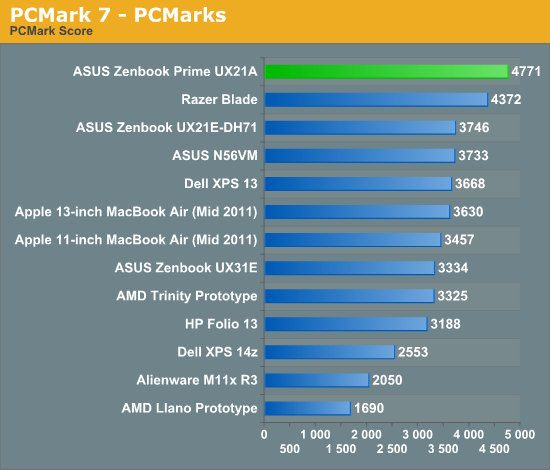
If you take into account Quick Sync and its SSD, the Zenbook Prime is an extremely quick solution. Looking at the breakdown of PCMark scores you get a much more realistic look at where the ULV IVB fits into things.

In some areas the Sandisk U100 holds the Zenbook prime back, here it's actually slower than its predecessor. Despite all of its issues throughout most of last year, SandForce was always fast.

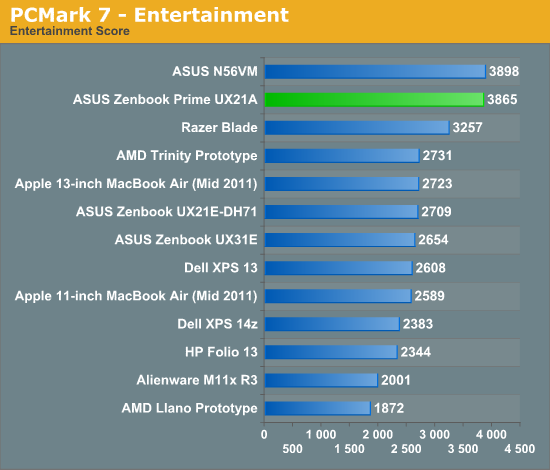

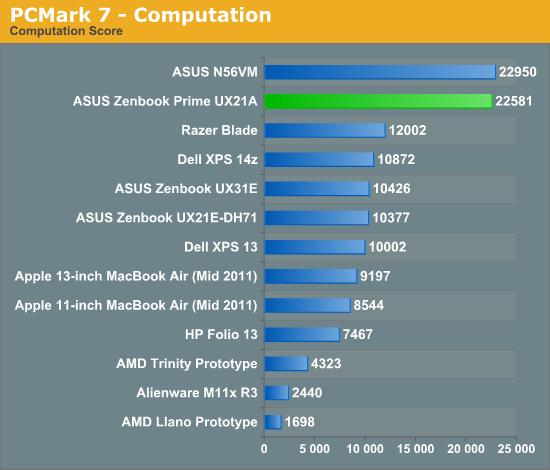
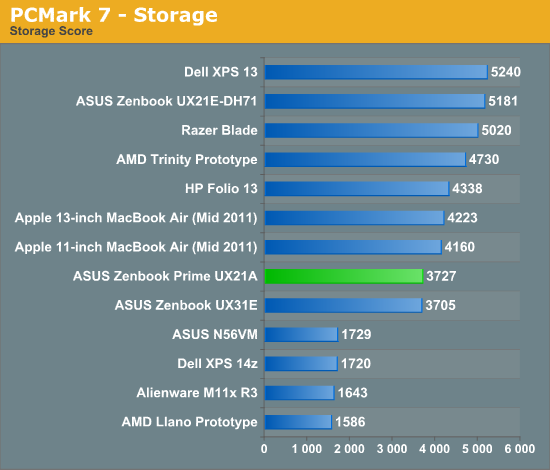
I threw in a PCMark Vantage graph as we have a lot of older data in that benchmark that can help put things in perspective:
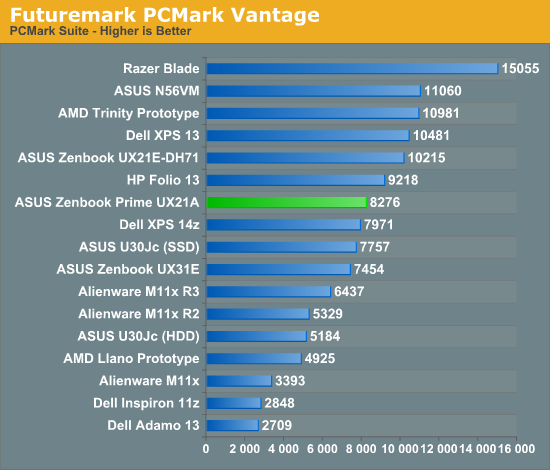
It's amazing the sort of performance gains we're able to show over the older Core 2 based ultra portables like the Dell Inspiron 11z and Adamo 13. Again we see a slight performance deficit versus the SandForce based UX21E.
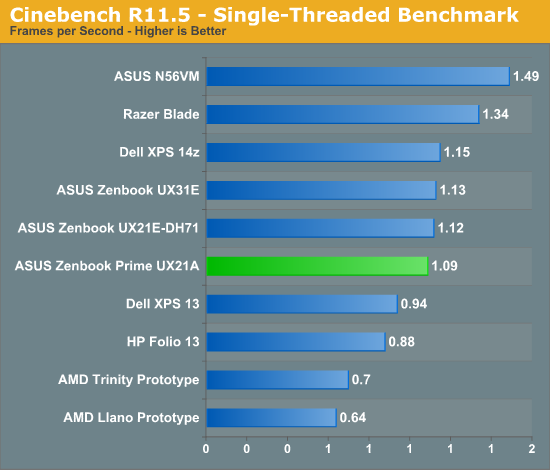
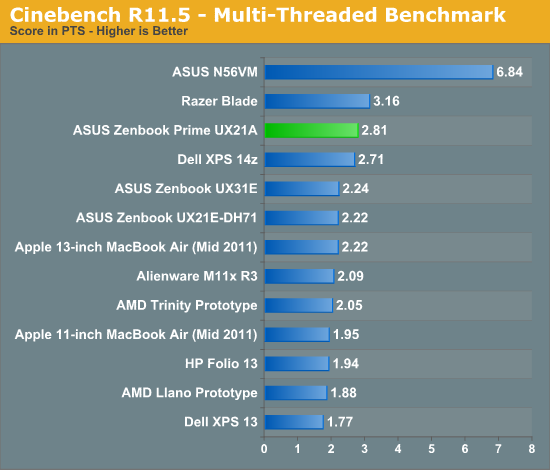

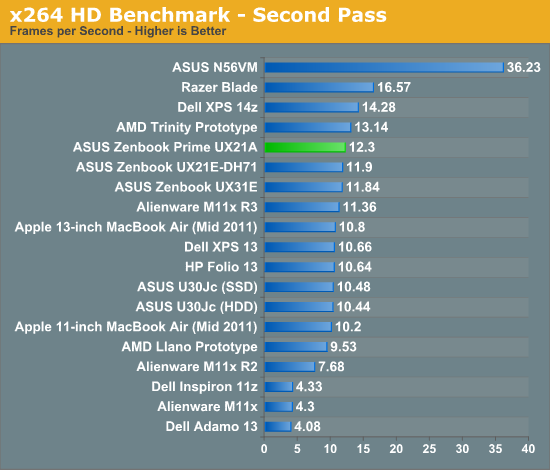










192 Comments
View All Comments
techexperience - Wednesday, May 23, 2012 - link
So, if what I see is correct, (and anand always delivers).The only difference between the Zenbook Prime UX32 $799 and $999 is hardisk space? From 320 GB to 500 GB for $200?By the way great post, Anand, as usual.
http://techexperience.net
ReverendDC - Wednesday, May 23, 2012 - link
I believe that the UX32 is also a little thicker, and the non-DV versions have a dedicated GPU. The hard drives are also platter, not SSD.ReverendDC - Wednesday, May 23, 2012 - link
Sorry, the DV version comes with the dedicated GPU.Reflex - Wednesday, May 23, 2012 - link
Likely a faster CPU as well.UrQuan3 - Wednesday, May 23, 2012 - link
Darn, I went with a Samsung 9 last year and can't afford to replace it yet. 13.3 is too big for me and 1366x768 is too low res. 12" and 1080p would be nice. Looks like an acceptable color gamut as well.Let's not make excuses for poorly written GUIs. They should resize. Games don't have a problem with that.
I do home Microsoft catches their resolution-vs-size mistake on Metro. Last I checked, Metro used fixed sizes and used higher resolutions to put more on the screen instead of allowing app links to resize. They were assuming that high resolution screens are also physically bigger. Of course that would be awful on a small, high res screen. Anyone know if they changed that?
Stanly.ok - Wednesday, May 23, 2012 - link
I look at official Asus slides (particularly at the top of second page) and can't help but wonder ... what kind of marketer or manager made them at the last moment instead of giving this job to a professional?!name99 - Wednesday, May 23, 2012 - link
" In practice I saw a doubling of performance under the same conditions as the original Zenbook (80Mbps vs. ~40Mbps)."This seems really bad. You should have got a doubling from 40MHz 5GHz channels, and a doubling from 2x MIMO. Are you sure the laptop and the base station are both set up optimally (most importantly both are in Greenfield mode so they're not wasting a huge amount of time with g compatibility)?
My 3 yr old MBA gets around 13MB/s to an 18 month old AEBS, and I've seen the new MBAs get around 20MB/s to that AEBS, and I expect even better to the newest AEBS.
IntelUser2000 - Friday, May 25, 2012 - link
I think its the way Anand tests it. On and Macbook Air 2011 review he gets 117Mbps which is 14.6MB/s.dczyz - Wednesday, May 23, 2012 - link
Since we dont have a new MX in the small form factor yet, that UX32VD-DB71 maybe what I do with. Cant wait to see a review on it.agent2099 - Wednesday, May 23, 2012 - link
The main fault I see in this device is the VGA port. They should have included a mini display port to complement the HDMI port. That way you could run two high-resolution displays from the laptop. With my current laptop I have the HDMI out going to the television and I have the mini display port going to my 24 inch monitor.